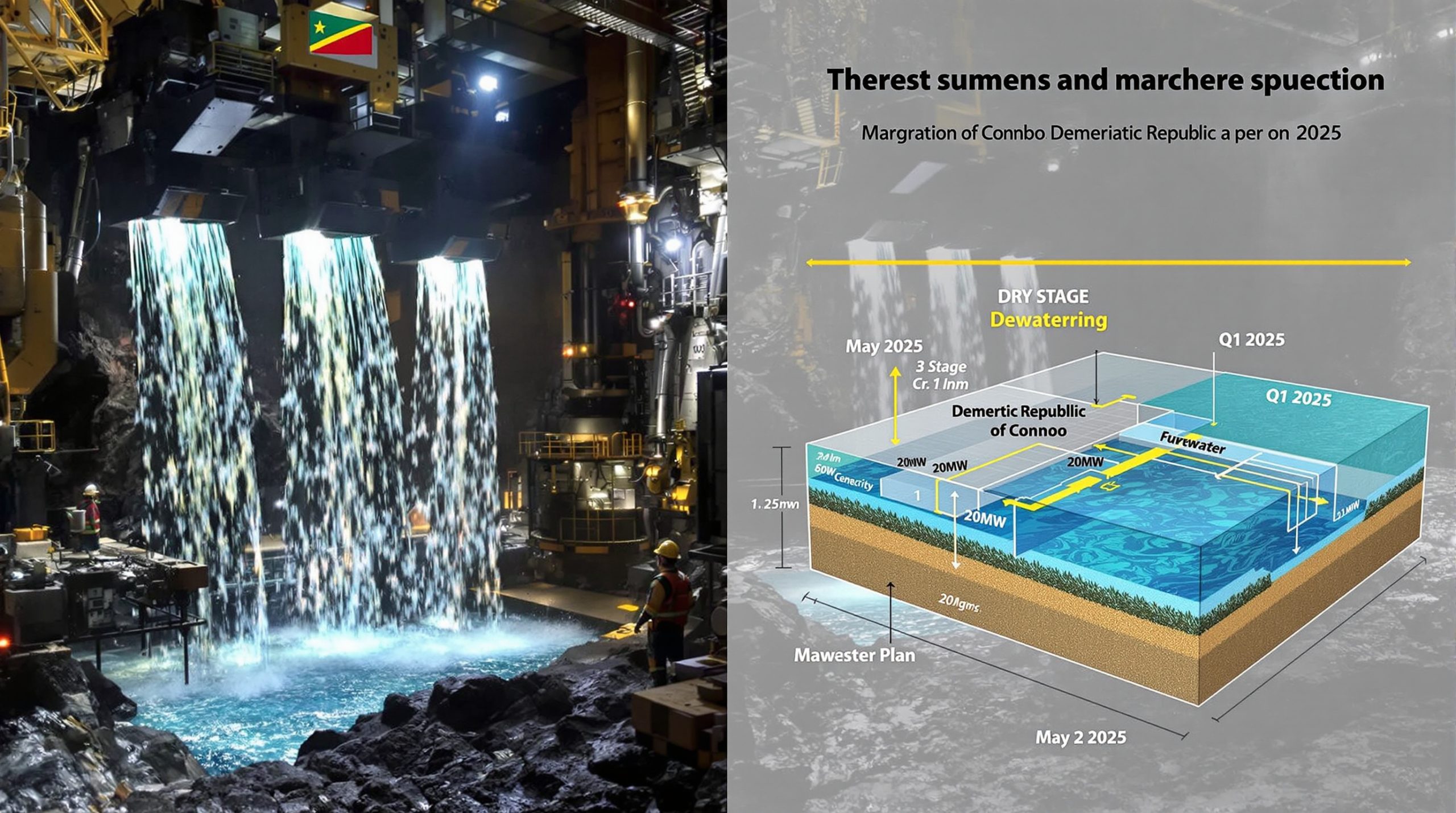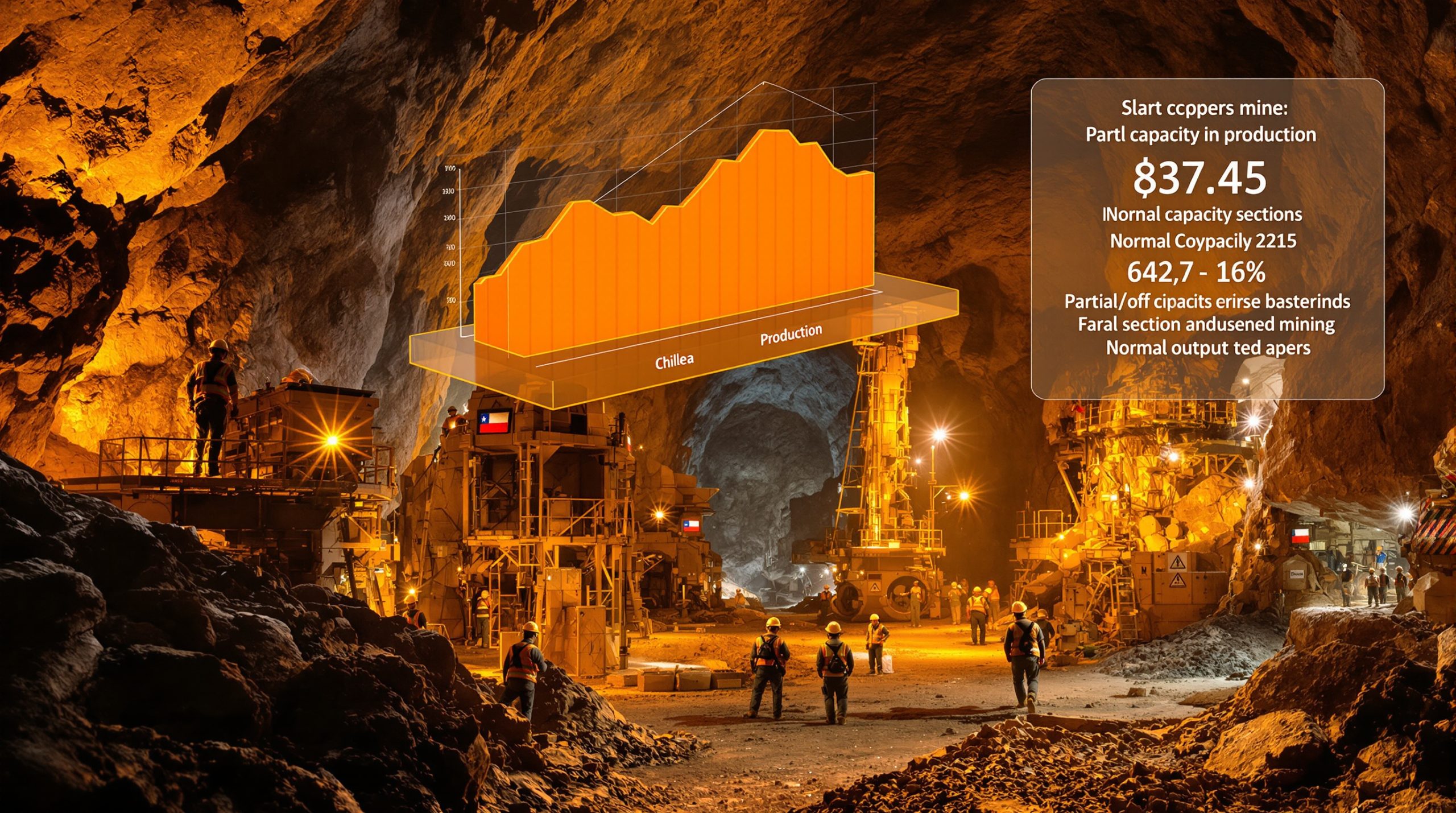How is First Quantum Expanding Copper Production in Zambia?
First Quantum Minerals (FQM) is implementing a comprehensive strategy to grow its copper footprint in Zambia, focusing on both extending the life of existing operations and developing promising new deposits. This approach balances immediate production needs with long-term sustainable growth in one of Africa's premier copper jurisdictions.
First Quantum's Strategic Investment in Prospect Resources
In April 2025, FQM made a decisive move by acquiring a 15% stake in Australia-listed Prospect Resources, instantly becoming the company's largest shareholder. This strategic investment positioned FQM as a key technical partner in the promising Mumbezhi copper exploration project, which is advantageously located approximately 30 kilometers from FQM's productive Sentinel mine.
"The Mumbezhi copper project represents a natural extension opportunity for our Sentinel operations," explained Anthony Mukutuma, FQM's country director for Zambia. "Initial exploration results have shown positive indicators that align with our expansion strategy."
The partnership structure allows FQM to leverage its extensive technical expertise while Prospect Resources contributes its exploration capabilities, creating a complementary relationship focused on accelerating resource definition.
The Significance of the Mumbezhi Project
Geological assessment of the Mumbezhi deposit has revealed promising similarities to the copper grade characteristics found at the Sentinel mine, suggesting potential for operational synergies if development proceeds. These early-stage geological correlations have generated significant optimism among project stakeholders.
Prospect Resources recently issued a statement emphasizing that ongoing exploration work has "strongly positioned Mumbezhi amongst the leading copper exploration assets in Zambia," highlighting the project's increasing prominence in the country's mining landscape.
The proximity to FQM's existing Sentinel infrastructure creates multiple advantages:
- Potential shared processing facilities
- Reduced capital requirements for development
- Streamlined logistics and transportation
- Experienced workforce availability
- Established community relationships
Industry analysts note that this "hub-and-spoke" approach to mine development—where satellite deposits feed central processing facilities—has proven successful in other mining jurisdictions for extending mine life while minimizing capital intensity.
Why is Extending Sentinel Mine's Life Critical for FQM?
The Sentinel mine represents the cornerstone of First Quantum's Zambian operations and a significant contributor to the company's global copper portfolio. Ensuring this asset's longevity stands as a strategic imperative for FQM's continued success in the region.
Sentinel Mine's Current Status and Importance
With approximately 12 years of operational life remaining based on current reserves, Sentinel faces the inevitable challenge confronting all mining operations—resource depletion. The mine's significance is underscored by its impressive production metrics, having yielded 231,000 metric tons of copper in 2024 alone.
This output represents more than half of FQM's total annual copper production of 431,000 tons, making Sentinel the single largest contributor to the company's copper portfolio. The mine's scale and efficiency have established it as a cornerstone asset, which explains why FQM is actively studying multiple options to extend its productive lifespan.
The economic implications extend beyond FQM's balance sheet, as Sentinel provides:
- Significant employment opportunities for local communities
- Tax revenue for the Zambian government
- Foreign exchange earnings for the national economy
- Procurement opportunities for local businesses
- Skills development and technology transfer
The Potential Impact of Mumbezhi on Sentinel
According to Anthony Mukutuma, FQM's country director, the Mumbezhi project "could have a significant impact on the mine life of Sentinel." This assessment is based on preliminary geological evaluations suggesting mineralization patterns similar to those found at Sentinel itself.
The geological similarities between Mumbezhi and Sentinel create potential for resource integration, where ore from the new deposit could be processed using existing infrastructure. This approach would maximize the value of FQM's previous capital investments while potentially adding years of productive operation.
Mining industry experts note that successful satellite deposit development could substantially extend Sentinel's productive years beyond the current 12-year horizon, potentially adding 5-10 years depending on resource definition and development timelines. Every additional year of operation represents significant value for both FQM and Zambia's mining sector.
What Other Expansion Projects is First Quantum Pursuing in Zambia?
Beyond the Sentinel mine extension strategy, First Quantum has demonstrated its long-term commitment to Zambia through significant investments in its other operations, particularly the Kansanshi mine complex.
Kansanshi Mine and Enterprise Nickel Expansion
FQM recently completed an ambitious $1.25 billion expansion project encompassing both the Kansanshi copper mine and Enterprise nickel operations. This substantial capital investment represents one of the largest recent mining developments in Zambia and affirms FQM's confidence in the country's mineral potential.
The expansion delivers two critical outcomes:
-
Extended operational life: The project will extend Kansanshi's productive lifespan to 2046, providing decades of sustainable mining operations.
-
Increased production capacity: Output at Kansanshi will rise to as high as 280,000 tons annually, representing a substantial increase from current levels of approximately 170,000 tons.
This expansion integrates advanced processing technologies and more efficient mining methods, improving both productivity and environmental performance. The Enterprise nickel component diversifies FQM's metal portfolio while leveraging operational synergies with the copper assets.
Strategic Importance of Zambian Operations
FQM's combined Zambian operations (Sentinel and Kansanshi) form the backbone of the company's global copper production portfolio. The long-term investment strategy demonstrates FQM's commitment to maintaining a significant presence in Zambia despite the cyclical nature of commodity markets.
The scale of these investments positions FQM as a cornerstone contributor to Zambia's national ambitions for copper price insights and sector growth. The company's expansion initiatives align with government policy objectives while delivering sustainable returns for shareholders—a balance that supports continued capital allocation to the region.
These strategic investments in both existing operations and exploration initiatives create a pipeline of development opportunities that can sustain FQM's Zambian copper production for decades to come.
How Does FQM's Expansion Fit into Zambia's National Copper Strategy?
First Quantum's aggressive expansion initiatives align perfectly with Zambia's ambitious national vision for copper production growth, creating a symbiotic relationship between corporate strategy and national economic objectives.
Zambia's Copper Production Targets
The Zambian government has established an ambitious target to increase national copper production to 3 million tons annually by 2031—a transformative goal that would cement the country's position as a global copper powerhouse. This target represents more than a tripling of current output levels.
Recent production figures show positive momentum toward this goal, with the country producing 821,000 tons of copper in 2024, marking a 12% increase from the previous year. This growth trajectory provides encouragement that the 2031 target, while ambitious, may be achievable with continued investment in mineral exploration importance and operational improvements.
As Africa's second-largest copper producer after the Democratic Republic of Congo, Zambia is strategically positioning itself to capitalize on growing global copper supply forecast. The country's geological potential, combined with an improving investment climate, creates favorable conditions for accelerated sector development.
Industry-Wide Expansion in Zambian Copper
FQM's investments are part of a broader industry movement toward expanding Zambian copper production. Several major mining companies are pursuing significant projects:
- Barrick Gold: Advancing expansion plans at its Lumwana operation to increase production and extend mine life
- Vedanta Resources: Implementing revival and growth strategies at the historic Konkola mine, with plans for $1 billion investment
- International Resources Holding: Following its recent acquisition of Mopani Copper Mines, planning substantial investments to revitalize these assets
These collective expansion efforts represent billions of dollars in committed capital that will support Zambia's national production goals. The coordinated growth across multiple operators suggests an industry-wide recognition of Zambia's copper potential and improving investment climate.
The alignment between corporate expansion plans and national objectives creates a positive feedback loop—government policies support mining investment, which delivers production growth, generating economic benefits that reinforce political support for the sector.
What is Driving Global Demand for Copper?
The strategic importance of investment in Zambia copper expansion is underpinned by robust global demand fundamentals that point toward a potential structural supply deficit in the coming decades, supporting long-term price strength.
Renewable Energy and Electric Vehicle Growth
Copper has emerged as a critical enabler of the global energy transition, with copper demand surges growing exponentially from two key sectors:
- Renewable energy infrastructure: Solar and wind power systems require 4-5 times more copper per megawatt than traditional power generation.
- Electric vehicles: A typical EV contains approximately 83 kg of copper, nearly four times the amount used in conventional internal combustion vehicles.
These demand drivers are supported by policy frameworks around the world that incentivize decarbonization through electrification. Major economies including China, the European Union, and the United States have established ambitious targets for renewable energy adoption and electric vehicle penetration, creating sustained demand growth for copper.
Industry analysts project that these sectors alone could drive an additional 5-7 million tons of annual copper demand by 2035, creating favorable long-term market conditions for producers like FQM with established operations and growth potential.
Copper's Role in Global Decarbonization
Copper's physical properties make it irreplaceable in the clean energy economy:
- Superior conductivity: Copper offers the highest electrical conductivity of any industrial metal, minimizing energy losses in transmission and distribution systems
- Durability: Its corrosion resistance ensures long operational life in exposed environmental conditions
- Recyclability: Nearly 100% recyclable without performance degradation, supporting circular economy objectives
- Thermal efficiency: Excellent heat transfer properties essential for motor efficiency and battery thermal management
These attributes position copper as the "metal of electrification," with demand growth directly correlated to decarbonization progress. Grid infrastructure modernization for renewable integration further increases copper intensity across the energy system.
The International Energy Agency has classified copper as a "critical mineral" for the energy transition, highlighting its strategic importance and the need for expanded production capacity to meet climate objectives.
What Challenges Might Impact FQM's Expansion Plans?
Despite the positive outlook for Zambian copper and FQM's strategic positioning, several factors could potentially impact the company's expansion trajectory. Understanding these challenges is essential for realistic assessment of development timelines and production targets.
Operational and Technical Considerations
Mining deeper and more complex deposits typically introduces additional operational challenges that can affect both costs and production efficiency:
- Increasing mining depths: As mines extend deeper, ventilation requirements increase while productivity can decrease
- Water management complexity: Responsible water stewardship becomes more challenging as operations expand
- Environmental compliance: More stringent requirements for tailings management and emissions control add to operational complexity
- Energy reliability: Despite improvements, Zambia still faces occasional power supply constraints that can impact processing operations
- Processing complexity: Lower-grade or more mineralogically complex ores may require additional processing steps or recovery optimization
Addressing these technical challenges requires continued investment in innovation and operational excellence. FQM's track record suggests the company has the technical capabilities to navigate these issues, but they nevertheless represent real constraints that must be managed.
Market and Economic Factors
External market conditions introduce additional variables that could affect expansion economics:
- Copper price volatility: While long-term fundamentals appear strong, short-term price fluctuations can impact investment return calculations and development timing
- Input cost inflation: Rising prices for energy, reagents, equipment, and skilled labor could pressure operating margins
- Global economic uncertainty: Broader economic conditions affect metal demand and investor sentiment
- Competition from other copper regions: Developments in Chile, Peru, and Indonesia could affect global supply-demand balances
- Potential changes in Zambian fiscal terms: Mining tax and royalty structures have evolved over time and future adjustments could affect project economics
Disclaimer: This analysis contains forward-looking statements regarding copper markets and mining developments. Actual results may differ materially from projections due to various factors including market conditions, operational challenges, and regulatory developments. Investors should conduct their own due diligence before making copper and uranium investment decisions.
FAQ: First Quantum's Zambia Copper Expansion
How much copper does First Quantum currently produce in Zambia?
First Quantum produced approximately 401,000 metric tons of copper in Zambia in 2024, comprising 231,000 tons from the Sentinel mine and approximately 170,000 tons from Kansanshi. This represents over 90% of the company's global copper production, underscoring Zambia's central importance to FQM's operations.
What is the expected timeline for developing the Mumbezhi project?
While specific development timelines have not been publicly announced, the Mumbezhi project is currently in the exploration phase with First Quantum serving as a technical partner to Prospect Resources. Typical development sequences suggest that following successful exploration, a pre-feasibility study would precede any construction decision, placing potential production several years in the future pending positive technical and economic outcomes.
How does Zambia's copper production compare to global output?
Zambia produced 821,000 tons of copper in 2024, making it Africa's second-largest producer after the Democratic Republic of Congo. Globally, this represents approximately 3-4% of world copper production. The country's ambitious target of 3 million tons by 2031 would significantly increase its global market share, potentially positioning Zambia among the world's top five copper producers.
What percentage of First Quantum's global copper production comes from Zambia?
Based on 2024 figures, Zambia accounts for approximately 93% of First Quantum's total copper production of 431,000 tons. This high concentration in one country highlights both the strategic importance of Zambian operations to FQM and the company's deep commitment to continued investment in the country's mining sector.
How might the Mumbezhi project impact First Quantum's production figures?
While specific production estimates for Mumbezhi have not been released, the project's potential to extend Sentinel's mine life suggests it could help maintain FQM's current production levels over a longer period. If the deposit proves substantial and development proceeds, it could eventually contribute additional production beyond simply replacing depleting Sentinel reserves, though quantitative projections await further exploration results and technical studies.
Further Exploration:
Readers interested in learning more about copper mining developments in Zambia can also explore related educational content from industry publications and government sources. The Zambia Chamber of Mines provides regular updates on sector developments, while technical mining journals offer insights into operational innovations being deployed at FQM's Zambian operations.
The copper market's evolving dynamics and Zambia's growing role in global supply present compelling subjects for investors, industry participants, and those interested in the critical minerals supporting the global energy transition.
Ready to Spot the Next Major Mineral Discovery?
Discover why historic mineral discoveries can generate substantial returns by exploring Discovery Alert's dedicated discoveries page, where our proprietary Discovery IQ model delivers real-time alerts on significant ASX mineral discoveries, instantly transforming complex data into actionable investment opportunities.




